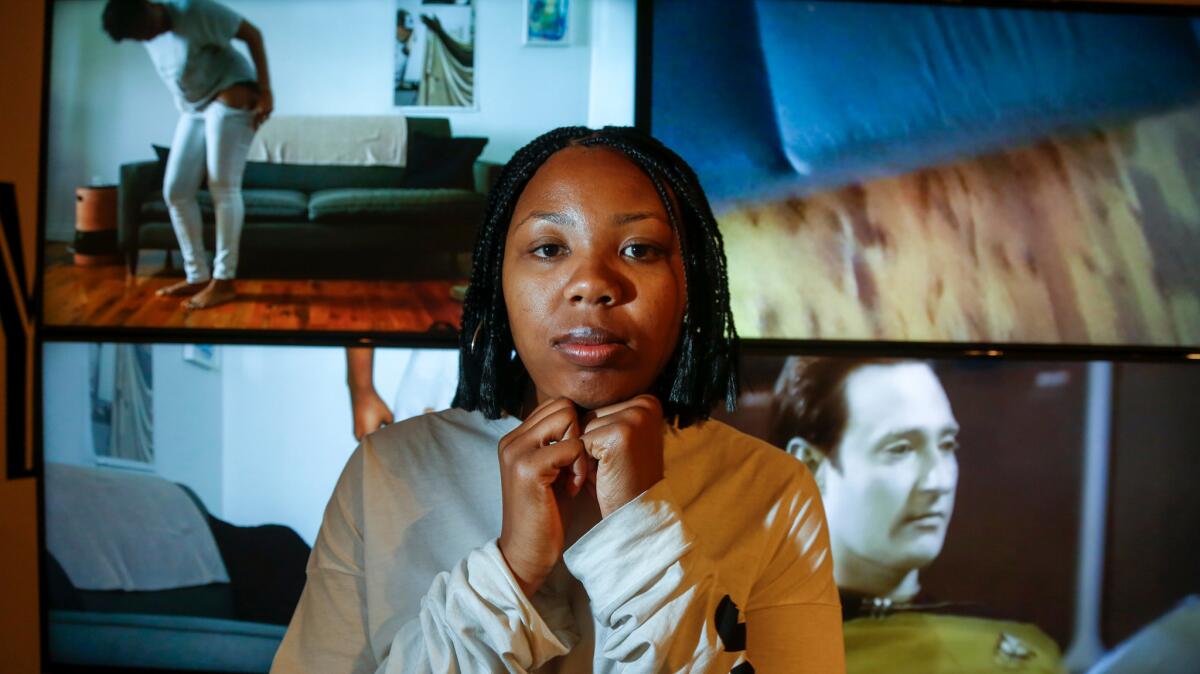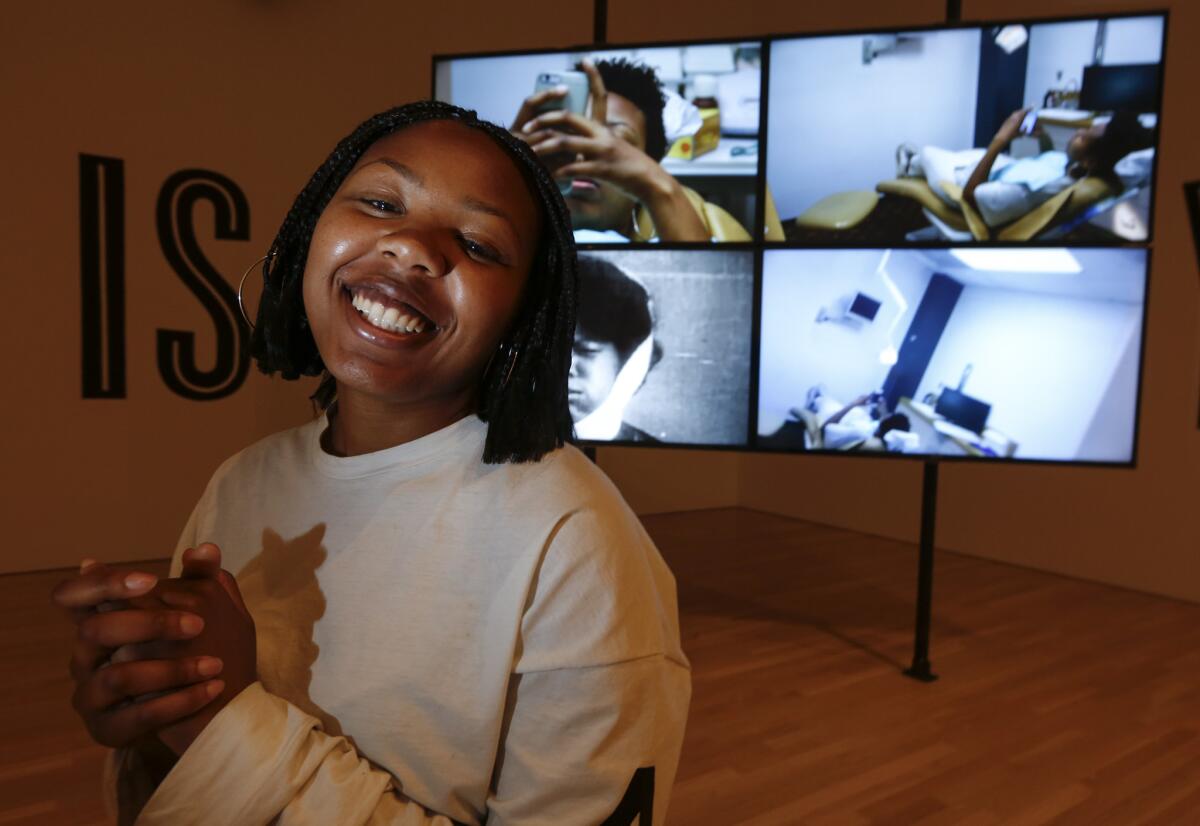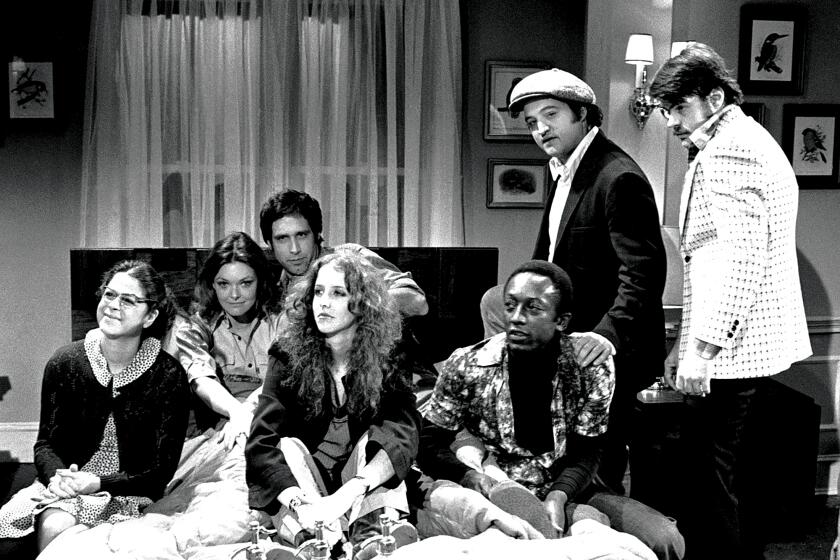At Hammer Museum’s ‘Made in L.A.’ biennial, Martine Syms makes her moment

- Share via
It starts with a burp. And she's mad.
Or maybe she isn't mad? Because she's laughing. Or she is mad and she's just pretending to be happy.
Then again, it could just be the laughing gas.
An undercurrent of uncertainty runs throughout Martine Syms' zany but heady video piece, "She Mad: Laughing Gas," which anchors her installation in the Hammer Museum's third biennial, "Made in L.A. 2016," opening Sunday. The seven-minute video is a fictional sitcom episode called "Laughing Gas" that's part of an invented TV series called "She Mad." Based on the 1907 silent film short "Laughing Gas," starring African American actress Bertha Regustus, Syms' piece follows an L.A. graphic designer and aspiring artist named Martine Syms who makes a comically ill-fated trip to the dentist. Syms plays the lead character who may or may not be based on herself, as is the Seinfeldian tradition.
"I'm consciously invoking those tropes," Syms says, sitting in the Hammer's courtyard. "A lot of my work, the subject is film and television itself, and history, and how that kind of coincides with larger cultural history and memory."
See the most-read stories in Entertainment this hour >>
Syms, 28, is very much of-the-moment. She’s an art darling, with a solo exhibition now at the Institute of Contemporary Arts in London, inclusion in the Hammer biennial and the ICA show opening at the Gallery of Modern Art in Glasgow, Scotland, in September. She’s also of-the-moment in her approach to conceptual art. Her work is rooted in the tradition of ’80’s appropriation art, but with a millennial twist. Toggling between publishing, performance, video, essay and photography, she melds images from her life and juxtaposes them against silent films from the turn of the 20th century and contemporary snippets from the Internet, TV and film to probe linguistic and visual representations of gender and African Americans in mass media.
It all simmers into what exhibition co-curator Hamza Walker calls "a wide-ranging bouillabaisse of pop culture."
"It's a portrayal of black middle-class life from a biographical perspective, and she'll appropriate all this other footage to voice: 'How do you see yourself when you weigh yourself against magazine imagery and TV and film? Do you see yourself?' Those are ongoing questions. She's fresh in terms of the range of her source material."
In Syms' "TV episode," after Martine has been doped up with laughing gas and is about to be operated on, she's told about a problem with her health insurance and sent home, still high. As she navigates the public bus and Koreatown sidewalks, a hilarity of sorts ensues — something that comes through in the presentation of the piece even more than the plot. Cameras offer varying viewpoints — head on, over the shoulder, above from the surveillance camera point of view — resulting in four video streams that play simultaneously on a grid of four flat-screen TVs, each with occasionally different soundtracks. Some screens may follow the narrative from different angles, while others intercut seemingly unrelated pop cultural tidbits: clips from “Star Trek,” “SpongeBob SquarePants” or “The Fresh Prince of Bel-Air,” with Internet GIFs, YouTube footage and still images from her computer archive.
The result is wacky and fast-paced, a Rubik’s Cube-like scramble of imagery bound by a loose, sitcom-simple storyline. Peel back the layers, however, and "She Mad" is teeming with depth, an exploration of race, identity and culture.
"If you would just empty out my brain, it's what I'm thinking about on any given day," she says, laughing. She pauses frequently, thoughtfully, referencing obscure film theory or esoteric essays. Then, just as frequently, she dissolves into giggles, her quick-shifting demeanor echoing the fragmented tenor of her video.

If that's at all unsettling, Syms says, that's the point. The split screens, blending of truth and fiction, layering of sound and saturation of images are meant to dizzy or destabilize the viewer and to upend assumptions. "So they consider a different experience from their own," she says, later adding: “Sure, I'm a black artist. But is that going to align with someone's expectations of black art? I have no idea. And I am not even interested in considering that."
Syms' dentist encounter in "Laughing Gas" is based on truth. She had nearly the same experience while living in the Midwest after graduating from the School of the Art Institute of Chicago. The 1907 silent film short of the same name features a bizarrely similar plot, in which the main character wanders the streets, high, after visiting the dentist. Syms found the parallel funny and the film historically significant.
"It's an early example of black women having a kind of subjectivity," she says.
Syms had all the music in her video composed so that it would be reminiscent of familiar sitcoms. The fleeting close-up shots — a book laying on the floor of her apartment or a block of text on her iPhone — are meant to prompt curiosity, so the viewer will look things up online afterward. She doesn't remember the names of every TV face she appropriated for the video, but no matter. The pictures were chosen only for an expression or feeling they evoke. And the stream of pop cultural imagery is "sort of a collective subconscious, like an ongoing annotation."
Syms grew up in Altadena as the fifth of six siblings. Neither parent was an artist. Her mother was a case manager and her father a survey engineer. But they were culturally engaged, she says, jazz and soul music fans who took the family to museums, concerts and comedy shows.
The independent films of John Waters and George Kuchar were among her early artistic influences. The Pasadena Armory Center for the Arts' after-school classes and the California State Summer School for the Arts program introduced her to experimental films and contemporary art as a teen. At CSSSA, she also discovered the Echo Park Film Center, which would become a lasting influence.
Shortly after graduating from college in 2007, she co-founded the bookstore and project space Golden Age in Chicago. In 2012 she founded the independent publishing company Dominica, which is "dedicated to exploring blackness as a topic, reference, and marker, and audience in visual culture."
I'm a black artist. But is that going to align with someone's expectations of black art? I have no idea. And I am not even interested in considering that.
— Martine Syms
So it’s not surprising Syms calls herself a "conceptual entrepreneur," alluding to the blurring of lines between art and business. To say that she is prolific would be an understatement. In the past six months, she's performed a lecture, "Misdirected Kiss," at the Broad museum in L.A.; showed 30-second video works, "Lessons," at the artist run space Human Resources in Chinatown; and exhibited photography at Karma International in Beverly Hills.
For the Hammer exhibition, which carries the full title “"Made in L.A. 2016: a, the, though, only” and presents emerging and underrepresented artists, Syms created a wall mural carrying the phrase "Is you is, or is you ain't." She also made an enlarged film still for the exhibit of the original "Laughing Gas" star, Regustus, into which she lasered abstract cutouts.
But there is never, ever, lack of time to watch TV. Syms is a junkie, highbrow and low, she says. "Nashville," "Scandal" and "How to Get Away With Murder" are favorites.
The sitcom, however, with its simplistic plot line, fast-pace and pliability, is what she prefers to work with, artistically.
"I think the sitcom is the format for television," she says. "It's the essential form and it represents more of the canon of TV, which is why I latched onto it."
The title of her own sitcom grew out of a joke with her boyfriend, she says.
“‘She Mad’ — it's like, 'Are you mad, bro?' It's a meme.”
As to whether or not Syms, herself, is actually mad?
"I may be. Or I may not be," she says slyly.
Then she falls into a fit of giggles.
------------
“Made in L.A. 2016: a, the, though, only”
Where: Hammer Museum, 10899 Wilshire Blvd., Los Angeles
When: Sunday-Aug. 28. Closed Mondays.
Admission: Free
Info: (310) 443-7000, hammer.ucla.edu
The biggest entertainment stories
Get our big stories about Hollywood, film, television, music, arts, culture and more right in your inbox as soon as they publish.
You may occasionally receive promotional content from the Los Angeles Times.








